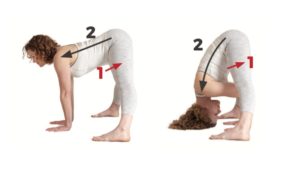
by Barrie
Forward bends are poses that stretch the back of the body, moving the torso and spine into flexion (the forward bend position) and closer toward the front of the body. They are poses that require a good deal of flexibility in the hips, hamstrings, and lower back to perform safely and well. Many of us are restricted in one or more of these areas, which makes this class of poses challenging and sometimes risky.
In this sequence, I invite you to look at how to practice these poses safely by examining two stages of forward folding, which I will explain next. I feel it’s important to do both stages, because if we skip stage one and go right to stage two, we will tend to overly round the upper back as we fold forward. This can load the vertebrae of the lower and mid-back in a way that can be risky for the back.
Here are some of the most important points to keep in mind about the mechanics of smart and safe forward bending as you practice stages one and two:
Stage One: Press your thigh bones down while lengthening your torso and spine to create a create concave lower back. It’s sometimes said that every forward bend begins with a backbend. This means that before folding forward, you establish the natural curve of the lower back (lumbar spine) by moving the top of the sacrum, the triangular bone at the back of your pelvis, in and lengthening the lower back up so the spine moves into a slight backbend (extension). For this to happen, your pelvis must tip over the head of your thigh bones. So, it’s by moving the thigh bones toward the hamstrings—what’s sometimes referred to as “grounding” the thigh bones—that we are able to get more ability to extend and lengthen the spine.
This can be a hard action for those of us who are tight in the hips or the hamstrings, so there are a couple of ways to work with that limitation. One way is to bend the knees and the other is to elevate the hips on a prop when we’re sitting.
Stage Two: After you’ve established the grounding of the thigh bones, the lengthening of the spine, and the creation of the curve of the lower back, begin to fold forward from the hip joints while maintaining that spinal extension as long as possible. This brings the back into a more convex, rather than concave position. In this position, gradually round from the lower spine upward so that the curvature of the spine rounding forward stays balanced and even through the length of the spine as much as possible.
Here are some other key points to help refine your practice of forward bends:
On an energetic level, when your head is supported, or in contact with something (either the legs or a prop), the head support is said to calm the front of the brain, which is the part involved in thinking, judgement, and reasoning, bringing us into a more introspective awareness. This is why I think it’s really effective to practice supported forward bends using blocks, a bolster, or a chair to support the forehead so that you can experience some of the calming benefits even if you aren’t able to fold all the way forward.
On a more symbolic level, the back of the body is the more universal part of ourselves and is associated with being more reflective. The front of the body is how we move forward into life as individuals and into action. By closing the front of the body and opening the back of the body, we can soften our sense of individuality and what holds us separate and get in touch with a more expanded and universal awareness where we can feel supported by the bigger whole of which we are a part.
As you move through this sequence, I invite you to notice the effect of the forward bends on your mind, your mood, and the quality of your awareness.
For those of you who are reading this post in your email, you can view the sequence by clicking on the title of the post to go to the blog and use the PDF reader there, or you can view and/or download the PDF using this link: https://drive.google.com/file/
Download a free class from Barrie’s new Yoga for Times of Change companion video series and learn more about her book Evolving Your Yoga: Ten Principles for Enlightened Practice at www.barrierisman.com.
• Follow Yoga for Healthy Aging on Facebook and follow Nina on Instagram • Order Yoga for Times of Change here and purchase the companion videos here • Order Yoga for Healthy Aging: A Guide to Lifelong Well-Being here.


Is this way of doing forward bends OK if one has osteopoenia or osteoporosis in the spine? Mine isn’t severe as far as I know and I able to bend forward easily. Have never been able to bend backwards much at all; there is no ‘natural curve’ in my back (per drs. etc.). Would love to do more forward bends but I believe that the Yoga for Healthy Aging book doesn’t recommend them for the above conditions? What are your thoughts?
Thanks —
Meredith
Thanks for your question, Meredith. You’re correct that deep forward bending is not recommended for those with osteoporosis or osteopenia due to the risk of fractures. However, for prevention it is excellent, and the strengthening work of the first stage I describe can be vey helpful. In the book Yoga for Osteoporosis, authors Ellen Saltonstall and Dr. Loren Fishman emphasize the 2-stage approach I offer here as “crucial for the safety and effectiveness of these poses.” Even if you don’t have a natural lumbar curve, you can practice this by moving from as low down in the spine as possible, tilting the pelvis forward from the hips, not the waist. Hope this helps! — Barrie Risman